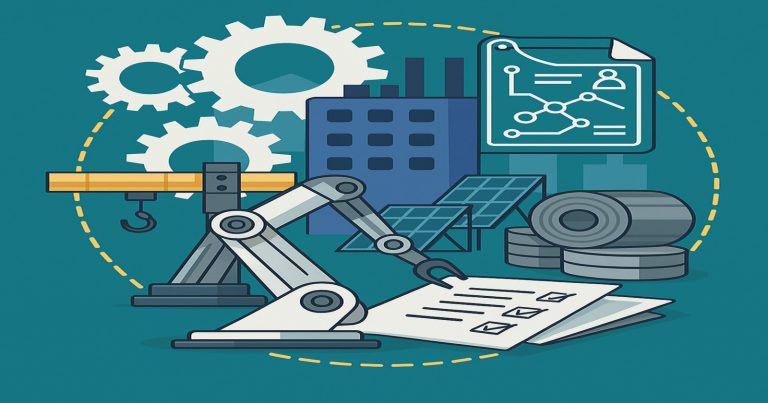Modern economies obtain their power not only from the extraction of natural resources but also from how such resources are transformed into consumable goods and services. Here comes the role of the secondary sector, which processes raw materials from agriculture, mining, and forestry into finished and semi-finished goods used in infrastructure and innovation. Such activities in this sector are focused on large-scale production in factories and include the evolution of complex manufacturing networks, high-tech electronic production lines, and small-scale construction projects that build up the basic needs of life. Secondary industries have become significant worldwide growth engines by converting crude materials into high-value goods.
From Cotton to Clothing, Ore to Infrastructure
The secondary sector is a part of nearly every facet of modern life. From producing steel for skyscrapers to assembling smartphones and creating textiles for international fashion brands, these changes are far-reaching and vital. The transformation occurs in various ways, some of them being
- Vehicles are assembled from metal, rubber, plastic, and electronics sourced from the far corners of the globe, supporting local jobs and international trade.
- In most cases, the textile sector converts raw cotton or synthetic fiber into the clothes we wear every day. These processes are often complex and labour-intensive.
- Consumer electronics like laptops, tablets, and smart appliances come from advanced manufacturing facilities, with parts supplied by dozens of vendors.
- Food processors take agricultural produce into packaged, preservable goods, catering to rural and urban markets.
- Construction workers take cement, steel, and glass, shape them, and mold them into homes for urban growth, offices, or a transportation system.
These sectors respond to local needs and supply the world market, placing them in the critical international trade arena.
Industrial Forces That Build Nations
Secondary industries are often categorized by the scale and intensity of their operations. While some focus on producing large-scale infrastructure or foundational materials, others cater to direct consumer needs. Their combined efforts build the industrial identity of a country.
Large-Scale Operations with Deep Economic Roots
This class of industries includes steel, shipbuilding, petrochemical, and machinery industries. They require huge capital investments, substantial energy, and heavy machinery for operations. Often touted as the foundation for an industrial economy, the government backs these sectors due to their long gestation period and strategic importance. Their ability to influence other sectors, such as construction, makes them distinctive. For example, steel from one city is used to build bridges in different cities. Long supply chains also drive the transport and logistics industry.
Flexible Producers of Everyday Goods
Consumer-focused production—home appliances, packaged foods, garments, or personal care items—takes place in smaller, faster production units. These industries are agile, require relatively less capital, and can adapt quickly to market changes. They contribute massively to employment and cater to both urban and rural markets. Because of shorter production cycles and lower overhead costs, they are ideal for countries with abundant labour and rising consumer demand.
The Builders of Urban Infrastructure
Though it doesn’t produce traditional “goods,” construction is vital to this sector. From laying down roads and building skyscrapers to constructing public facilities and modern housing, construction brings tangible results from industrial output. It’s labour-intensive, project-driven, and directly tied to economic growth indicators like housing demand, urban expansion, and infrastructure investment.
Industrialisation’s Ripple Effect on Growth
The influence of the secondary sector goes well beyond factories and production lines. It catalyses development across nearly every economic layer.
- Secondary industries help generate crucial foreign exchange and improve the national trade balance by turning raw goods into high-value exports.
- New factories mean new jobs. Whether on assembly lines or in supporting logistics, the employment impact of this sector is vast.
- Innovation is driven by the need to produce more, faster, and cheaper. That leads to research, automation, and technological upgrades.
- Urbanisation is powered by manufacturing hubs that attract workers, leading to new cities and improved infrastructure.
- As plants and units spread to rural or underdeveloped areas, economic growth becomes more balanced and inclusive.
Secondary industry acts as a bridge, connecting raw resource potential with consumer satisfaction and underdeveloped regions with national prosperity.
Role of Secondary Industry in Economic Development
The secondary industries are detrimental to transforming an agricultural economy into one of manufacturing. They also add value to the raw materials while making a dramatic contribution to a country’s GDP. The industries are vital for urbanisation, investment, and job creation across the regions. Growth in these industries increases demand for other sectors. Countries with serious attention to strengthening secondary industries, such as China, South Korea, and Germany, have witnessed rapid and sustained economic growth. Conversely, economies relying on the primary sectors generally suffer due to low income and volatility. In India, the secondary industry contributes approximately 25-30% of the GDP. It is, therefore, at the heart of schemes such as ‘Make in India’ that aim to encourage local manufacturing and cut down on imports. The sector also addresses regional imbalances by setting up industries in rural and backward regions. Power, logistics, banking, and insurance- ripple effects for development.
Manufacturing Clusters and Industrial Zones in India
India’s secondary sector is geographically concentrated in industrial zones and clusters that specialise in particular types of manufacturing. These clusters promote specialisation, improve supply chain integration, and reduce production costs. They also benefit from the regional policies, subsidies, and infrastructure support the central and state governments provide.
Some prominent clusters include:
- Gurugram & Manesar (Haryana): Known for automobile manufacturing, including Maruti Suzuki and Hero MotoCorp.
- Surat (Gujarat): Famous for textile and diamond polishing industries, employing millions in labor-intensive processes.
- Pune (Maharashtra): A hub for auto parts, IT hardware, and precision engineering.
- Tiruppur (Tamil Nadu): A globally significant knitwear and garment cluster.
- Bangalore (Karnataka): The electronics and semiconductor design capital of India.
These zones are often linked to Special Economic Zones (SEZs) and industrial corridors like the Delhi-Mumbai Industrial Corridor (DMIC), which aims to connect manufacturing hubs with ports, reducing logistics time and boosting exports. These hubs play a strategic role in making Indian manufacturing globally competitive.
Interdependence of Heavy and Light Industries
Heavy and light industries may seem distinct, but they are deeply interconnected through supply chains and resource dependencies. Heavy industries like steel, cement, and petrochemicals provide manufacturers in light industries with the essential materials for producing their end-user products. For instance, automobile manufacturing (a light industry) greatly depends on steel, rubber, and glass (all heavy industry products).
Such demand-symbiosis strengthens the ecosystem with layered demand while allowing it to scale economically. The growth of a light industry segment often leads to increased production in its upstream heavy industry, promoting job creation, infrastructure development, and technological innovation across the board.
A Snapshot of Industrial Dynamics
The following table shows how varied and essential the secondary sector is across functional and economic dimensions.
| Category | Focus | Scale | Examples |
| Capital-Intensive Units | Bulk materials and infrastructure | Large-scale | Steel plants, chemical factories |
| Labor-Driven Production | Consumer and fast-moving goods | Small to medium | Garments, food processing, cosmetics |
| Infrastructure Builders | Physical construction & real estate | Project-based | Roads, housing, and commercial complexes |
Secondary Industry FAQS
1. What is the purpose of the secondary industry?
The primary purpose of the secondary industry is to convert raw materials into finished or semi-finished products that serve consumer needs or support other sectors. It adds economic value and fuels industrial growth.
2. What is the disadvantage of the secondary industry?
One significant disadvantage is environmental impact, such as pollution and resource depletion. Additionally, it requires high capital investment and is sensitive to market and labor fluctuations.
3. What are the 3 main types of secondary industry?
The three main types are heavy industry (e.g., steel production), light industry (e.g., consumer electronics), and the construction industry (e.g., roads, buildings, infrastructure).
4. What are the challenges of the secondary sector in India?
Challenges include inadequate infrastructure, inconsistent power supply, complex regulations, limited access to advanced technology, and regional disparities in industrial development.
5. How is the secondary sector evolving in the digital age?
With the rise of automation, AI, and Industry 4.0, the secondary sector is becoming more tech-driven, efficient, and capable of producing more innovative, sustainable products at scale.


